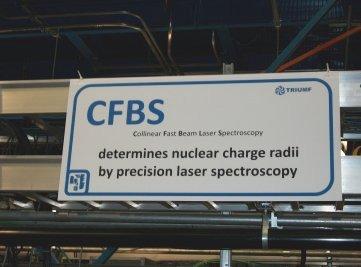 In a physical system as complex as the atomic nucleus, empirical measurements provide direction and crucial tests for various nuclear structure theories and models. For this purpose, optical spectroscopy of atomic electron orbitals has been used to probe atomic nuclear structure for over a century. Its most successful modern incarnation is collinear laser spectroscopy, in which a beam of ions emits fluorescence following excitation by a tunable laser. In recent decades, new techniques have been developed to increase the sensitivity of this approach in order to make the most of low production-rates for short-lived and rare isotopes. The TRIUMF laser spectroscopy experiment exploits several of these techniques, notably the use of a gas-filled RFQ (radio-frequency quadrupole), or Paul trap, to cool and bunch the beams—a technique which allows for a background suppression by several orders of magnitude. Combined with the considerable intensity and purity of the ion beams produced by the ISAC isotope production facility, this offers the potential for unmatched sensitivity in measuring the hyperfine levels of very difficult-to-produce ion beams, providing a new window into the behaviour of highly unstable atomic nuclei.
In a physical system as complex as the atomic nucleus, empirical measurements provide direction and crucial tests for various nuclear structure theories and models. For this purpose, optical spectroscopy of atomic electron orbitals has been used to probe atomic nuclear structure for over a century. Its most successful modern incarnation is collinear laser spectroscopy, in which a beam of ions emits fluorescence following excitation by a tunable laser. In recent decades, new techniques have been developed to increase the sensitivity of this approach in order to make the most of low production-rates for short-lived and rare isotopes. The TRIUMF laser spectroscopy experiment exploits several of these techniques, notably the use of a gas-filled RFQ (radio-frequency quadrupole), or Paul trap, to cool and bunch the beams—a technique which allows for a background suppression by several orders of magnitude. Combined with the considerable intensity and purity of the ion beams produced by the ISAC isotope production facility, this offers the potential for unmatched sensitivity in measuring the hyperfine levels of very difficult-to-produce ion beams, providing a new window into the behaviour of highly unstable atomic nuclei.
Up | Next: Theory |
